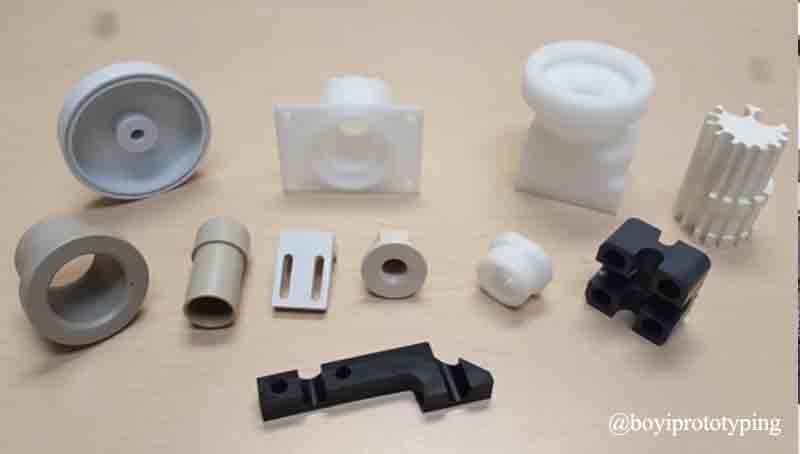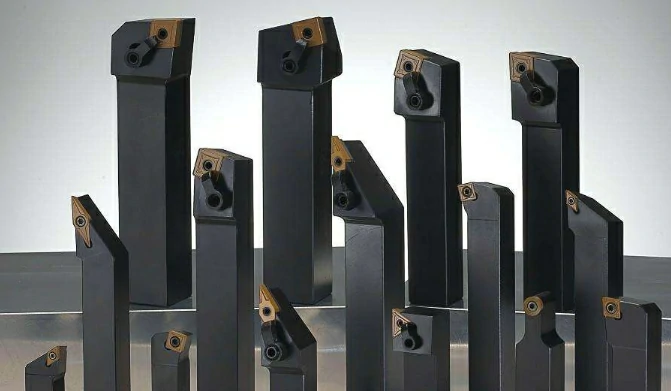ABS (Acrylonitrile Butadiene Styrene) plastics are widely used in industrial applications due to their high strength, excellent chemical resistance, and ease of processing. This article aims to provide a comprehensive guide to the precision machining of ABS plastics, including machining methods, tool selection, machining parameters, and troubleshooting tips, to help readers better understand and apply ABS plastic machining techniques.

Properties of ABS Plastics
When machining ABS plastics, understanding its properties and applying appropriate techniques are crucial for achieving desired results.
Mechanical Properties:
ABS plastics are renowned for their high impact resistance, rendering them ideal for applications where durability is paramount. Whether it’s withstanding sudden shocks or enduring repeated stresses, ABS exhibits remarkable toughness.
While ABS may not boast the highest tensile strength among engineering plastics, it offers a moderate level of strength that is sufficient for many applications. Additionally, ABS maintains good stability under various loads, ensuring structural integrity over time.
One of the notable characteristics of ABS is its moderate flexibility. This property allows ABS to bend and deform to a certain extent without breaking, making it easy to shape and mold into intricate designs.
Thermal Properties:
ABS plastics typically have a melting point ranging from approximately 200 to 250°C. This melting point provides a wide processing window for molding and shaping ABS materials under controlled temperatures.
ABS exhibits thermal expansion when subjected to heat. Machining ABS requires careful consideration of this property to prevent dimensional inaccuracies or warping due to temperature fluctuations during the process.
Chemical Properties:
ABS plastics demonstrate good resistance to acids and alkalis, enhancing their suitability for applications where exposure to corrosive substances is a concern. However, it’s important to note that certain solvents and hydrocarbons may affect the integrity of ABS over time, necessitating careful material selection for specific environments.
Electrical Properties:
ABS is highly regarded for its excellent electrical insulating properties. This characteristic makes ABS an optimal choice for electrical enclosures, components, and housings where insulation against electrical currents is essential.
Related Resources: ABS vs PLA Differences
Machining Techniques for ABS
CNC machining and injection molding are commonly used methods for precision machining of ABS plastic.
CNC Machining

CNC (Computer Numerical Control) machining is a process that utilizes computer-controlled tools and machine tools for automated machining. For ABS plastic components, CNC machining offers high precision and efficiency. Operators use pre-programmed instructions to guide the tools on the machine to cut along specific paths and depths. This method is suitable for machining parts with complex shapes and ensures dimensional accuracy and surface quality.
Via the following form, you can gain a clear understanding of the properties of ABS plastics and their machining technique requirements, ensuring high-quality and precise results during the machining process.
| Machining Method | Tools | Speeds and Feeds | Cooling |
|---|---|---|---|
| Cutting | High-speed steel (HSS) or carbide-tipped tools | High cutting speeds (300-600 m/min), moderate feed rates (0.1-0.3 mm/rev) | Use air or minimal coolant to avoid thermal expansion and deformation. |
| Drilling | Standard twist drills | High speeds (1000-3000 RPM), low feed rates (0.05-0.2 mm/rev) | Prefer compressed air cooling to maintain dimensional stability. |
| Milling | Carbide cutters | High spindle speeds (4000-8000 RPM), moderate feed rates (0.1-0.5 mm/tooth) | Air cooling or light mist to prevent thermal damage. |
| Turning | Carbide or HSS tools | High spindle speeds (500-1500 RPM), moderate feed rates (0.1-0.3 mm/rev) | Minimal coolant or air cooling recommended. |
| Grinding | Fine-grit silicon carbide or aluminum oxide wheels | Moderate speeds to avoid overheating | Light coolant mist to maintain surface finish and dimensional accuracy. |
Surface Finish for ABS Plastic Parts
Surface finishing options for CNC-machined ABS parts offer various choices to achieve desired appearances and properties. Here’s a breakdown of common methods:
- Bead Blasting: This method employs abrasive particles like sand or glass beads to refine ABS surfaces, creating a smooth, matte texture that enhances visual appeal and can be a cost-effective means to improve aesthetics.
- Metallic Coating: Electroless and immersion plating methods infuse ABS parts with a metallic sheen by applying metals like aluminum and zinc. This enhances durability, resistance, and visual appeal, providing both aesthetic and functional benefits.
- Painting: Adhesive painting offers color versatility, allowing customization to specific requirements. This method, particularly effective after bead blasting, results in a durable finish that enhances appearance and longevity.
- Polishing: Mechanical or chemical polishing smoothens ABS surfaces, creating a glossy finish. This process improves aesthetic appeal, making parts suitable for high-end applications where visual appearance is crucial.
- Clear Coating: Applying a transparent coating enhances ABS part durability and appearance by protecting against scratches and UV damage. This method preserves the natural appearance of ABS while providing added protection, making it ideal for outdoor or high-visibility applications.
Injection Molding
Injection molding is a commonly used plastic processing technique suitable for mass production of ABS plastic components. The process involves melting ABS plastic pellets and injecting them into molds, which are then cooled to form the desired parts. Injection molding achieves high efficiency and consistency in production and can manufacture parts with complex shapes. For precision parts, the design and manufacture of molds are crucial to ensuring dimensional accuracy and surface quality.
Advantages and Disadvantages of ABS Machining
This table provides a clear comparison of the strengths and weaknesses of ABS plastic machining.
| Advantages | Disadvantages |
|---|---|
| Versatility: Can be molded into various shapes | Poor Weather Resistance: Susceptible to degradation and color fading |
| Impact Resistance: Excellent durability | Low Heat Resistance: Limited suitability for high-temperature applications |
| Surface Finish: Achieves smooth and glossy surfaces | Warping and Shrinkage: Can affect dimensional accuracy |
| Chemical Resistance: Resistant to many chemicals | Flammability: Releases toxic gases when burned |
| Machinability: Easily machined using common methods | Surface Scratching: Prone to scratching and abrasion |
Applications
ABS (Acrylonitrile Butadiene Styrene) plastic has a wide range of applications in industry and daily life, with various processing methods available to suit different needs. Here are some applications of ABS processing in various fields:
| Application | Examples of Usage |
|---|---|
| Automotive Industry | Body panels, dashboard, door handles, interior panels, etc. |
| Electronics | Computer casings, keyboards, telephone casings, speaker casings, etc. |
| Furniture and Home Goods | Furniture components, drawers, hangers, kitchen utensils, etc. |
| Medical Equipment | Casing for medical instruments, handles, brackets, etc. |
| Toys and Gaming Equipment | Building blocks, models, game controllers, etc. |
Best Practices
Here are five effective tips for machining ABS:
- Opt For Machine-Grade ABS Plastic: Choose machine-grade ABS plastics tailored for tasks like CNC milling or turning. These grades ensure optimal chip formation and superior surface finish, enhancing the quality of machined parts.
- Select Appropriate Cutting Tools: Use cutting tools specifically designed for plastics to prevent damage to the surface. Maintain tool sharpness to ensure precise machining and avoid plastic deformation.
- Fine-Tune Cutting Parameters: Adjust cutting depth, speed, and feed rate to avoid part deformation or machining chatter. Securely hold ABS parts during machining to prevent distortion caused by excessive pressure.
- Employ Appropriate Coolant: Use non-aromatic, water-soluble coolants designed for plastic machining to prevent overheating and deformation. Apply coolant as a pressurized gas jet, continuous mist, or flowing liquid, depending on part design.
- Perform Annealing: Consider annealing ABS plastic before machining to relieve internal stresses and ensure dimensional stability. Annealing involves heating the plastic to a specific temperature, holding it, and then slowly cooling it down to alleviate stress and improve machinability.
Implementing these tips will help achieve high-quality and precise machining results when working with ABS plastic.
ABS Machining Challenge
Here’s a closer look at these challenges:
- Machining Complexity: Crafting high-quality, precision-machined parts from ABS plastic requires the right equipment and expertise. Even experienced machinists can face hurdles when handling ABS plastic, especially without the proper understanding. Common defects may only become apparent after completing the workpiece.
- Defects: ABS plastic often exhibits two common machining defects: distortion and subpar surface finish. Tooling marks or chatter lines can mar parts, while scratches and imperfections can affect transparent ABS parts or cause leaks in fittings during processing.
- Surface Quality: Surface quality issues can result from using the wrong cutting tools, incorrect cutting parameters, or excessive heat buildup. These factors can compromise the surface finish of ABS parts, impacting their appearance and functionality.
- Tackling Distortion: Avoiding distortion is a significant challenge when working with ABS plastic. ABS plastics exhibit significant thermal expansion when heated, leading to potential distortion if excessive material is removed. This distortion becomes evident as the part cools and contracts.
- Heat Concerns: ABS plastics have relatively low heat deflection temperatures and thermal conductivities. Consequently, heat can accumulate rapidly during machining, causing the plastic to soften and deform. Proper cooling techniques and control of machining parameters are essential to mitigate heat-related issues.
By understanding and addressing these challenges, manufacturers can achieve high-quality, precise results when machining ABS plastic, ensuring the integrity and functionality of the finished parts.
Conclusion
In conclusion, ABS machining, including CNC machining and injection molding, offers a myriad of applications and advantages, rendering it a valuable choice across diverse industries. With BOYI as your manufacturing partner, you can rely on expertise and quality to meet your specific needs in precision ABS fabrication. Whether it’s intricate CNC machining or efficient injection molding, BOYI ensures excellence in every aspect of ABS plastic manufacturing.
Let’s Start A New Project Today
FAQ
ABS plastics possess a combination of excellent mechanical strength, rigidity, and impact resistance, making them ideal for precision machining applications where high accuracy and dimensional stability are required.
Precision machining of ABS plastics offers several advantages, including high dimensional accuracy, excellent surface finish, and the ability to create complex geometries. It ensures tight tolerances, making it suitable for applications where precision is crucial, such as automotive parts and electronic enclosures.
Catalog: CNC Machining Guide

This article was written by engineers from the BOYI team. Fuquan Chen is a professional engineer and technical expert with 20 years of experience in rapid prototyping, mold manufacturing, and plastic injection molding.




